#alcazar of Córdoba
Explore tagged Tumblr posts
Text





May 2023. Posted 12/23
The Alcázar de los Reyes Cristianos or Alcazar of Cordoba
#alcazar of Córdoba#original photography on tumblr#landscape photography#spain#vacation spain#Castle#snapseed
181 notes
·
View notes
Text
ALCAZAR DE LOS REYES EN CÓRDOBA, DE PALACIO CALIFAL A RESIDENCIA DE MONARCAS; Por Rosana Saburo
Aunque la conozcas, vuelves a la ciudad de Córdoba porque cuando la descubres, sorprende y la admiras. Paseando por su Judería, las flores toman el protagonismo en la ciudad, más aún durante primavera, siguiendo sus callejones, enfrente de la Mezquita, buscando el cauce del río Guadalquivir, llegamos al Alcázar de los Reyes, levantado en el siglo XIV, aprovechando la estructura y jardines del…
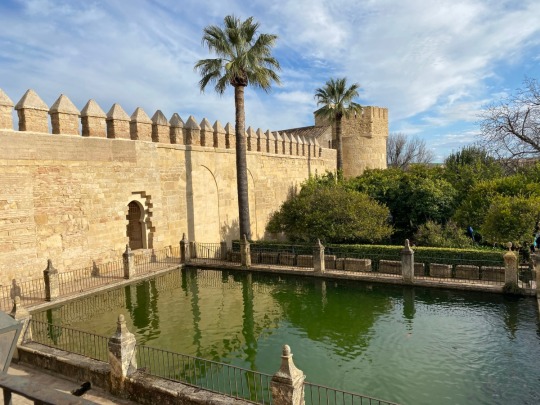
View On WordPress
#alcazar de los reyes#Alcázar#califal#jardines andalusis#mosaicos#palacios#patio mudejar#patrimonio de la humanidad#plaza de la corredera#torre del homenaje#Turismo córdoba
0 notes
Text
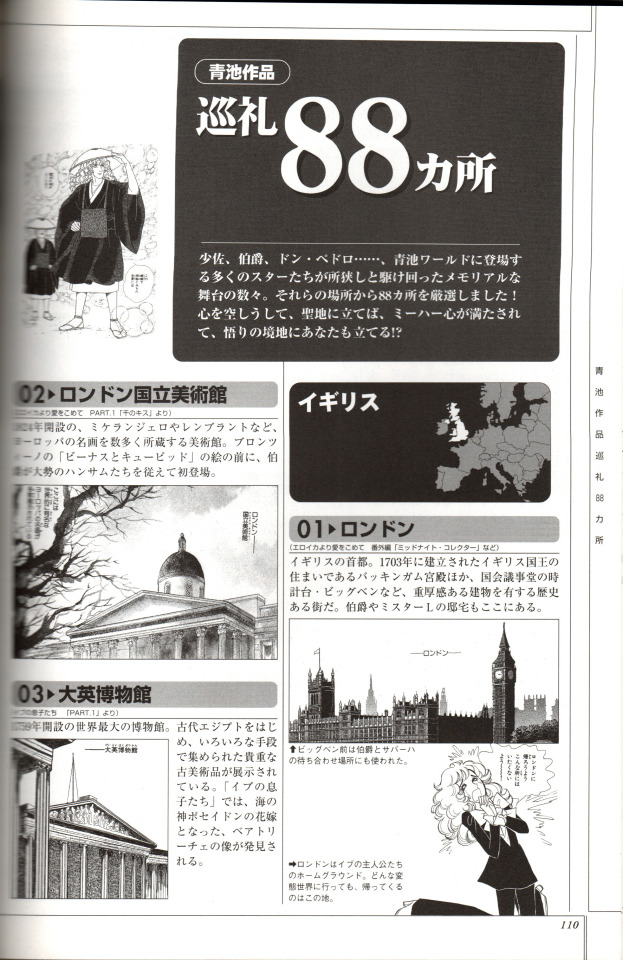


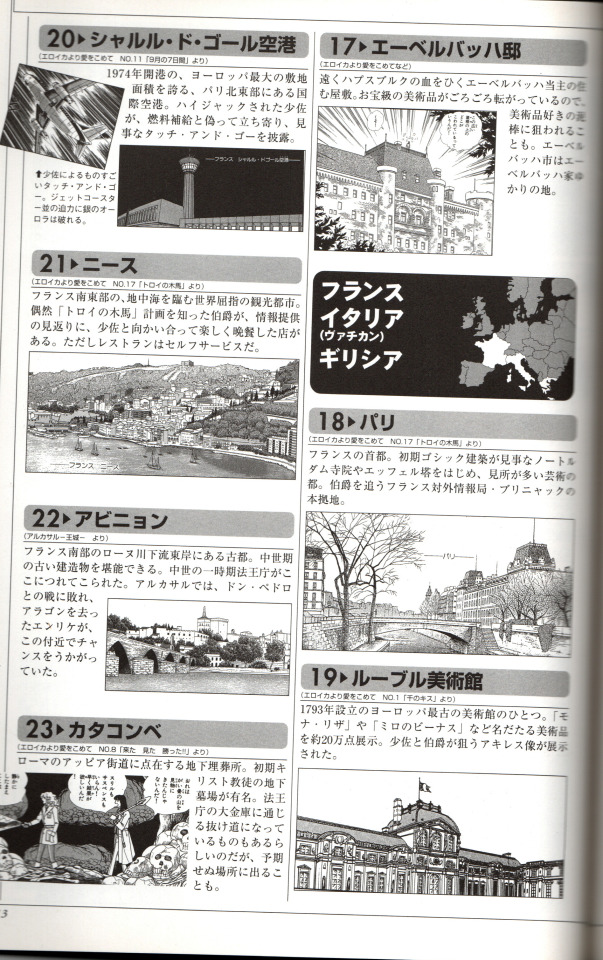
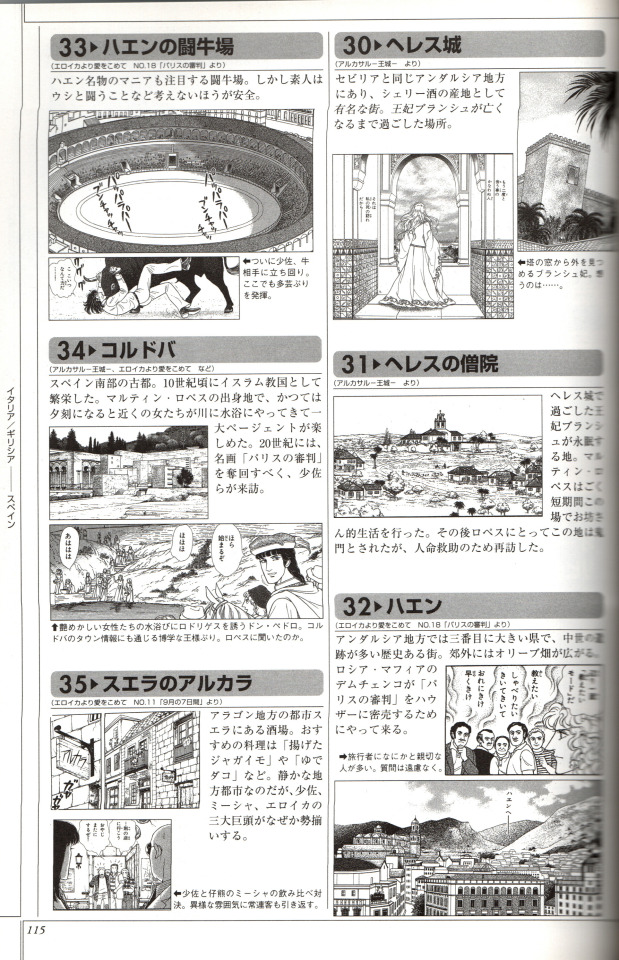
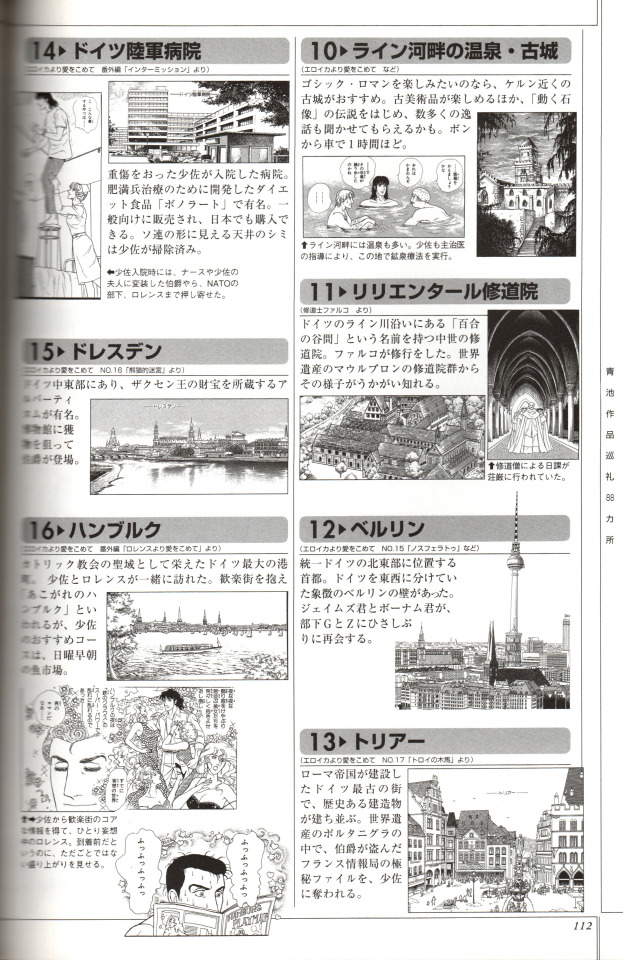
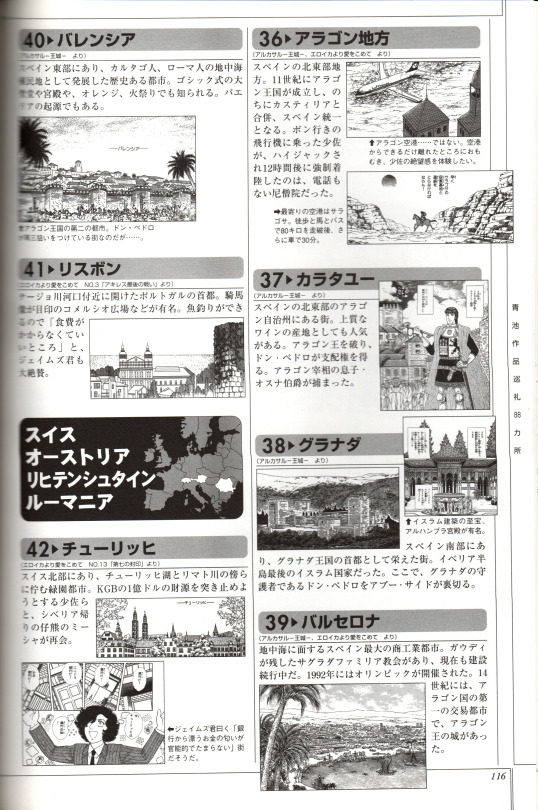


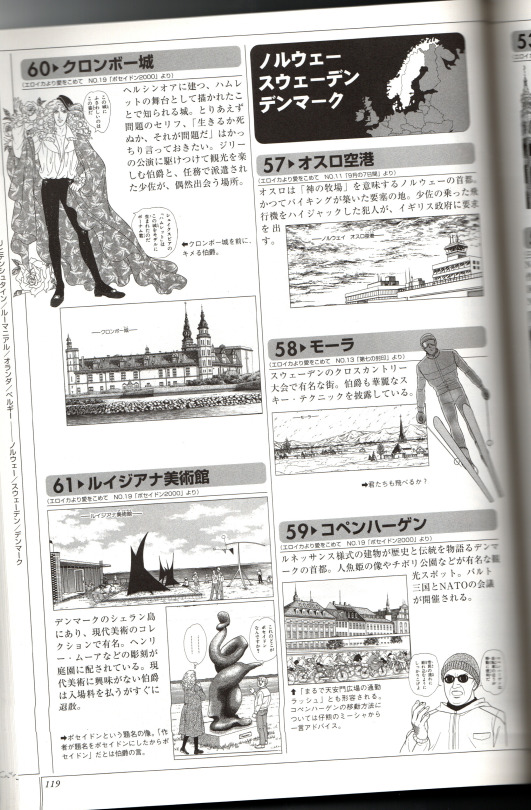
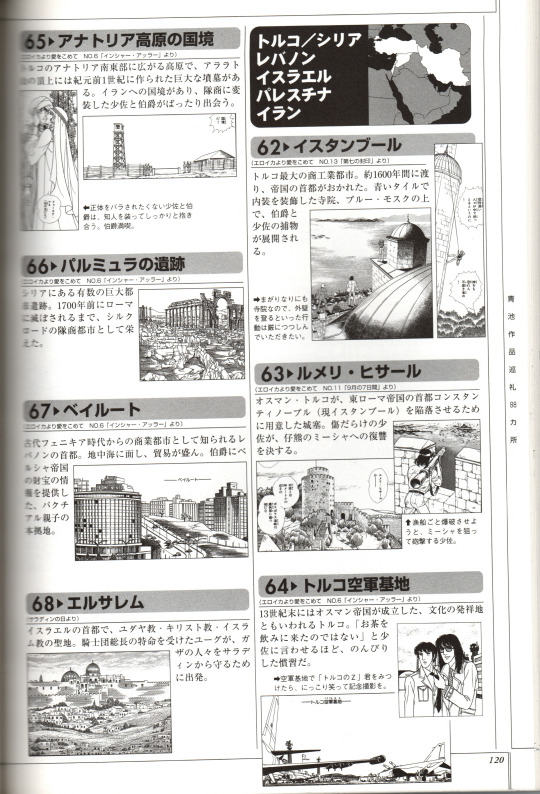
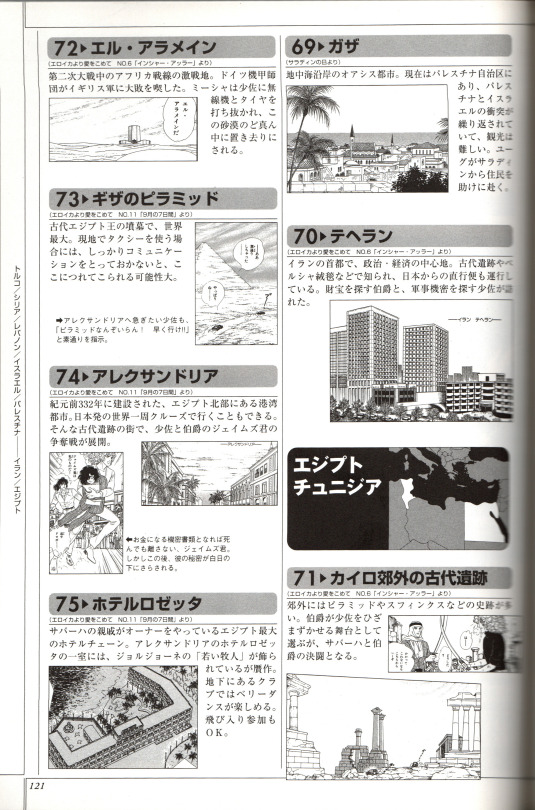


aoike character guide book
places visited in yasuko aoike's works (translation under the cut by the lovely @asnowperson)
ENGLAND 1- London (Midnight Collector side story among others) 2- The National Gallery (London) (Pt.1 A Thousand Kisses) 3- British Museum (London) (Pt.1) 4- Salibury Military Base (Lieutenant Colonel Eberbach side story) 5- Heathrow Airport (No.11 Seven Days in September among others)
GERMANY 6- Plymouth (El halcón) 7- Bonn 8- NATO Bonn Office 9- Cologne 10- Thermal Spas on the Rhine River and the old castles (Eroica, among others) 11- Lilienthal Monastery (Shuudoushi Falco) 12- Berlin (No. 15 Nosferatu, among otheres) 13- Trier (No.17 Trojan Horse) 14- German Military Hospital (Intermission side story) 15- Dresden (No.16 The Panda’s Maze) 16-Hamburg (From Lawrence with Love side story) 17- Eberbach Mansion
FRANCE/ITALY/GREECE 18- Paris (No.17 Trojan Horse) 19- Louvre Museum (No.1 A Thousand Kisses) 20- Charles de Gaulle Airport (No.11 Seven Days in September) 21- Nice (No.17 Trojan Horse) 22- Avignon (Alcazar Oujo) 23- Catacombes (No.8 Veni Vidi Vici) 24- St.Peter’s Basilica (No.8 Veni Vidi Vici) 25- St.Peter’s Square (No.8 Veni Vidi Vici) 26- Parthenon Temple (No.4 Love in Greece)
SPAIN/PORTUGAL 27- Sevilla (Alcazar Oujo) 28- Sigüenza (Alcazar Oujo) 29- Toledo (Alcazar Oujo) 30- Jerez Castle (Alcazar Oujo) 31- Jerez Monastery (Alcazar Oujo) 32- Jaén (No.18 Judgment of Paris) 33- Plaza de Toros de Jaén (No.18 Judgment of Paris) 34- Córdoba (Eroica) 35- Zuera, Alcala (No.11 Seven Days in September) 36- Aragon region (Eroica) 37- Calatayud (Alcazar Oujo) 38- Granada (Alcazar Oujo) 39- Barcelona (Eroica) 40- Valencia (Alcazar Oujo) 41- Lisbon (No.3 Achilles’ Last Stand)
SWITZERLAND/AUSTRIA/LICHTENSTEIN/ROMANIA 42- Zürich (No.13 The Seventh Seal) 43- Luzern (No.12 The Laughing Cardinals) 44- Vienna State Opera (No.14 Emperor Waltz) 45- Vienna Central Cemetery (No.14 Emperor Waltz) 46- Innsbruck (No.14 Emperor Waltz) 47- Innsbruck Airport (No.14 Emperor Waltz) 48- Hofburg Palace (No.14 Emperor Waltz) 49- Tyrol region (No.14 Emperor Waltz) 50- Lichtenstein (No.13 The Seventh Seal) 51- Romania military base (No. 15 Nosferatu)
THE NETHERLANDS/BELGIUM 52- Amsterdam (Eroica, Madan no Shashu) 53- Bruxelles (No.17 Trojan Horse) 54- NATO HQ (No.19 Poseidon 2000) 55- European Commission HQ (No.13 The Seventh Seal) 56- Antwerp (No.17 Trojan Horse)
NORWAY/SWEDEN/DENMARK 57- Oslo Airport (No.11 Seven Days in September) 58- Mora (No.13 The Seventh Seal) 59- Copenhagen (No.19 Poseidon 2000) 60- Kronborg Castle (No.19 Poseidon 2000) 61- Lousiana Museum of Modern Art (No.19 Poseidon 2000)
TURKEY/SYRIA/LEBANON/ISRAEL/PALESTINE/IRAN 62- İstanbul (No.13 The Seventh Seal) 63- Rumeli Hisarı (No.11 Seven Days in September) 64- Turkish air base (No.6 Inshallah) 65- National borders of Anatolian plateau (No.6 Inshallah) 66- Historical remains of Palmyra (No.6 Inshallah) 67- Beirut (No.6 Inshallah) 68- Jerusalam (Saladin no Hi) 69- Gaza (Saladin no Hi) 70- Tehran (No.6 Inshallah)
EGYPT/TUNISIA 71- Ancient remains outside Cairo (No.6 Inshallah) 72- El Alameyn (No.6 Inshallah) 73- Giza Pyramids (No.11 Seven Days in September) 74- Alexandria (No.11 Seven Days in September) 75- Hotel Rosetta (No.11 Seven Days in September) 76- Carthage (No.17 Trojan Horse)
RUSSIA/JAPAN/USA/OTHERS 77- Moscow (No.19 Poseidon 2000) 78- St. Petersburg (No.18 Judgment of Paris) 79- Hermitage Museum (No.18 Judgment of Paris) 80- Siberia (A Tale of Alaska side story) 81- Uspensky Air Base (Eroica) 82- Tokyo Tower (Hiiro no Yuuwaku) 83- Alaska (A Tale of Alaska side story) 84- FBI Fairbanks Office (No.9 The Alaskan Front) 85- Tazlina Lake (No.9 The Alaskan Front) 86- Hawaii (No.9 The Alaskan Front) 87- West of Eden (Eve no Musukotachi) 88- Olympos (Eve no Musukotachi)
#this ones actually in order since everything is numbered#charabook#from eroica with love#sons of eve#el halcon#alcazar#etc etc#yasuko aoike#my scans#mine
24 notes
·
View notes
Text






Out In The Wild no.26 featuring The Realm in Córdoba.
So I know I said Merida was my favourite but Cordoba takes 1st place. It was an amazing place. So filled with culture and beautiful architecture.
While there I visited;
🇪🇸The Mezquita-Cathedral of Cordoba Bell Tower
🇪🇸The Mezquita-Cathedral of Cordoba
🇪🇸The Alcazar De Los Reyes Cristianos
🇪🇸Palace of Páez de Castillejo
🇪🇸Puente Romano
🇪🇸Puerta Del Puente
#the realm#debut novel#booklr#booktok#writer of tumblr#fantasy#writeblr#young adult#in the wild#out in the wild#Travel#spain#Merida
2 notes
·
View notes
Text
Banu Qasi triology: Locations (+ Maps extracted from the book and modern reconstruction of plans of some cities of that period of time I found on Internet)
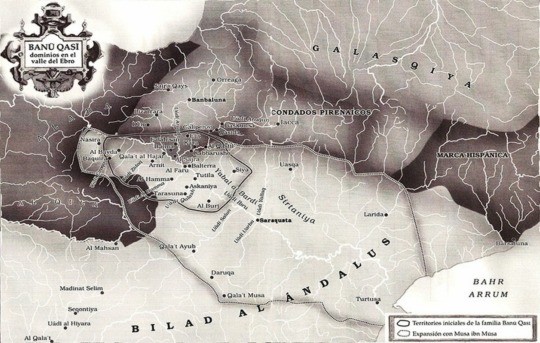


(* Some towns and cities that already existed are not in this maps, but probably were not included in the maps because maybe they're not relevant for the story, X, X, X )
Zaragoza (×) (although this one represents the Zaragoza from 11th century, due to the presence of the Palace of Aljaferia (×), although a watchtower existed since 9-10th centuries in that place, the Troubadour's Tower, that currently forms part of the palace)
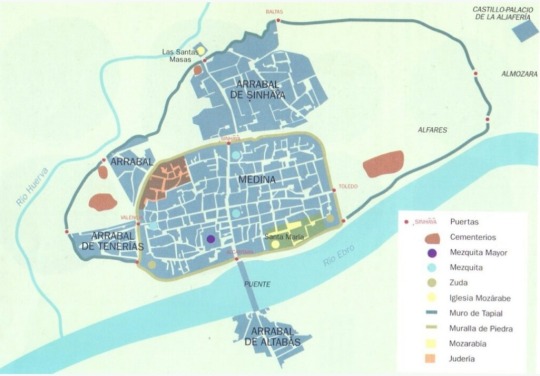
Tudela, but here's a video of Pamplona/Iruña
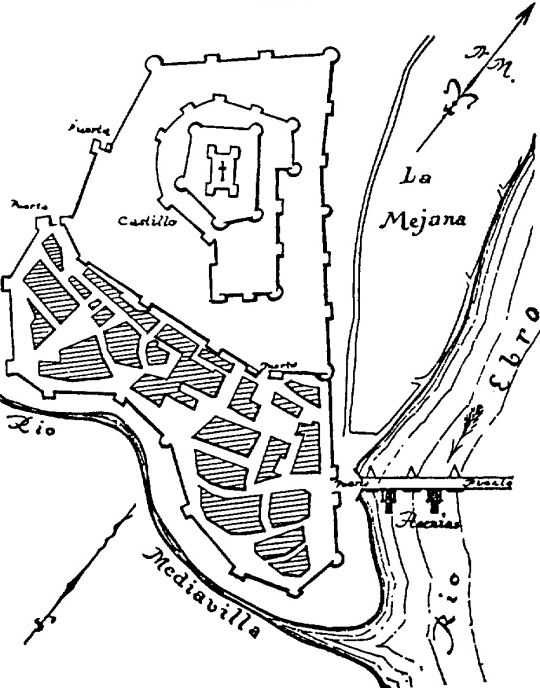
Córdoba (Here's a video with the current-day Alcázar and the Caliphal baths)
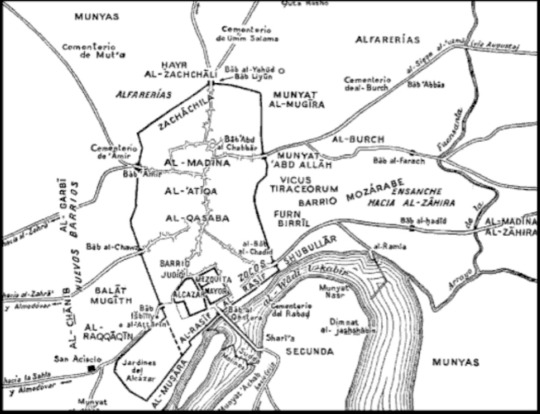
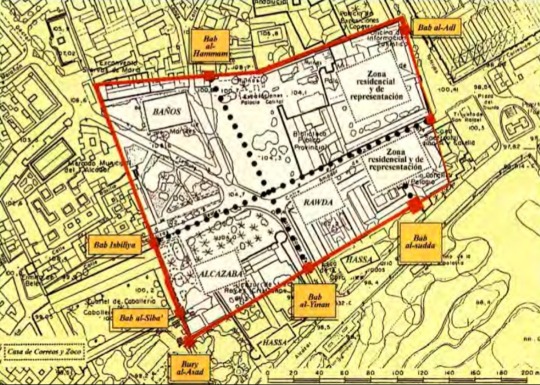

Toledo
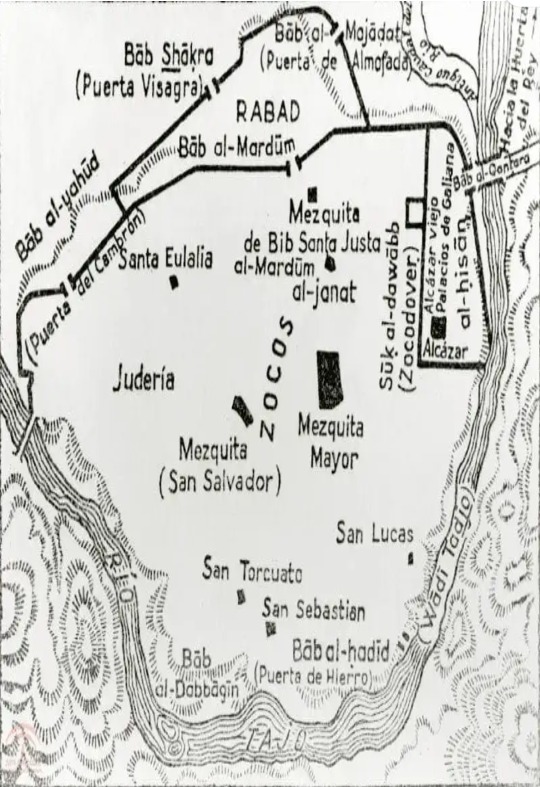
Alaba: Álava
Al Bayda, Albayda: Albelda
Al Burj: Borja
Al Busherat: Las Alpujarras
Al Faru: Alfaro
Al Garb: 'the west', Algarve
Al Hamma: Alhama
Al Hamma: site that corresponds to the current Baños de Fitero
Al Hamra: 'the red', the Alhambra of Granada
Al Lura: Álora
Al Maghrib: current Maghreb area, Morocco, Algeria and Mauritania
Al Mahdiyya: capital of the Fatimid Caliphate founded by Al Mahdi
Al Mariya: Almería
Al Mahsan: Almazán
Al Mudawar: Almudévar
Al Munastir: Almonacid
Al Qala't: Alcalá de Henares
Al Qāhira: Cairo
Al Qastil: Carcastillo or Murillo el Fruto
Al Qila: Castile
Al Qulaiya: Alcolea
Al Qubba: Talavera
Al Rawda: one of the interior gardens of the alcazar of Córdoba, where most of the emirs were buried
Al Sarqiyya: Axarquía, in Granada
Al Xaraf: Aljarafe
Al Jazira: Algeciras
Almunya de Aisha: Muniesa
Al Sajra: Azagra
Antaqira: Antequera
Arnit: Arnedo
Aryiduna: Archidona
Askaniya: Cascante
Asturqa: Astorga
Asnad:Cenes
Astīban: fortress located in the current-day Alhambra
Aura: Fortress next to Barcelona, possibly in present-day Valldaura
Aybar: Aibar
Bab al Qantara: the Bridge Gate, in Córdoba, also known as Bab as-Sudda or the Azud Gate
Baghdad: capital of the Abbasid emirate
Bagúh: Priego
Bahr Algarbí: Atlantic Ocean
Bahr Arrum: Mediterranean sea
Balaga: Balager
Balma: place located on the left bank of the Ebro river next to Calahorra, it may correspond to the town of San Adrián
Balansiya: Valencia
Balterra: Valtierra
Bambaluna: Pampiluna, Pamplona
Banu Basir: Benameji
Baquira: Viguera
Barbitaniya: región of Sobrarbe, that included Jaca, Barbastro and Boltaña
Barsaluna: Barcelona
Baskunsa: place name that would correspond to the fortress of Rocaforte, which after the Reconquest, it would give to the current Sangüesa, located at the foot of this valley
Batalyus: Badajoz
Barbastur: Barbastro
Bayanna: Baena
Bayāna: Pechina, important trading city of the Mediterranean sea, replaced by the port of Almería
Basta: Baza
Bilad al Ándalus: Hispania
Bulāy: Poley, Aguilar de la Frontera
Burbaster: Bobastro, Umar ibn Hafsún's shelter
Cantabria: mountain range that borders river Ebro by the north, next to Logroño
Castro Muros: San Esteban de Gormaz
Dar al Islam: the lands of Islam
Dar al Rahn: the House of Hostages, in Córdoba
Daniya: Denia
Daruqa: Daroca
Deio: Monjardín
Dus Amantis: the Rock of the Lovers
Falah'san: Falces
Fās: Fez, capital of the Idrisi emirate
Finyāna: Fiñans
Galaskiya: Land of the galaskiyun, the gascons
Galipenzo: Gallipienzo
Garnata: Granada
Girunda: Girona
Hardaris: Ardales
Hisn Asar: Iznájar
Hisn Qámara: castle of uncertain location, near Colmenar and Casabermeja, in the province of Málaga
Hisn Qastuluna: the ancient Roman city Cástulo, in Jaén
Iacca: Jaca
Ifriqiya: Tunisia
Ilbira: Elvira, next to Granada, capital of the distrit with the same name.
Isbāniyā: Christian chroniclers called the peninsula as a whole Hispania. For the Arabs, Al Ándalus is only the land dominated by Islam. They call the Christian land by the name of their kingdoms, and the term Isbāniyā is reserved for the entire peninsula, although it is rarely used.
Ishbiliya: Sevilla
Istiba: Estepa
Istiya: Écija
Kabbaruso: Caparroso
Kara: Santacara
Larida: Lleida
Ledena: Liédena
Leqant: Fuente de Cantos
Liyun: León
Lizarrara: Estella-Lizarra
Madinat Selim: Medinaceli
Madinat al Faray: Guadalajara
Malaqa: Málaga
Mārida: Mérida
Martus: Martos
Milīla: Melilla
Millas: Mijas
Muish: Muez
Munt Sun: Monzón
Munt Liyūn: Monteleón
Mursiya: Murcia, also known as Tudmir (this name comes from the Visigothic count Teodomiro, who ruled it by the time the Muslims arrived to the Peninsula)
Nasira: Nájera
Niebla: District that corresponds to the current-day province of Huelva
Orreaga: mountains of Ibañeta or Roncesvalles
Ossa: Huesa del Común
Qabra: Cabra
Qabtil: Isla Menor (Sevilla)
Qadis: Cádiz
Qala't al Hajar/Qalahurra: Calahorra
Qala't al Hans: Alange
Qala't Gazuan: Alcalá de Guadaira
Qala't Ayub: Calatayud
Qala't Musa: Calamocha
Qala't Rabah: Calatrava
Qarmuna: Carmona
Qarqar: Cárcar
Qasida: Cáseda
Qarcastil: Carcastillo
Qasr Bunayra: Casarabonela
Qayrawán: Kairuán, capital of Ifriqiya, current-day Tunis
Quluniya: Clunia
Qumaris: Comares
Quriya: Coria del Río
Qurtuba: Córdoba
Qustantaniyeh: Constantinople
Qutanda: Cutanda
Raya: district that corresponds to the province of Málaga
Rasif: A promenade in Córdoba that ran along the right bank of the Guadalquivir river
Resa: fortress located on the banks of the Ebro, near the mouth of the river Arga
River Eiroca: River Iregua
River Iberus*: River Ebro
*the Iberian peninsula takes its name from the river Iberus/Ibero, the river Ebro
Rumiya: Rome
Sabta: Ceuta
Salubāniya: Salobreña
Santabariyya: Santaver, Muslim district that corresponds to the province of Cuenca
Saqunda: village in the suburb of Córdoba, on the left bank of the Guadalquivir river
Sajra Qays: Qays rock, fortress located near the current-day town of Huarte Araquil, in the Rock of Echauri, northwest of Pamplona
Saraqusta: Zaragoza
Seqontiya: Sigüenza
Siduna: Medina Sidonia
Sirtaniya: La Cerretania, in the Aragonese area of the Pyrenees, around the valleys of the Gállego and Cinca rivers. This denomination disappears from the sources from the 10th century, when the County of Aragon appears
Siya: Ejea de los Caballeros
Suhayl: Fuengirola
Sumuntān: Somontín
Tahert: city in the north of Africa, in Algeria
Tahust: Tauste
Takurunna: one of the corias of Al Andalus, with capital in Ronda
Tarraquna: Tarragona
Talyayra: fortress located below Bobastro, over the Guadalhorce river.
Tarasuna: Tarazona
Tāy^ula: Tíjola
Tulaytula: Toledo
Turtusa: Tortosa
Tutila: Tudela
Uādi al Hamma: River Alhama
Uādi al Hiyara: Guadalajara. At first, the name of rhe city was Madinat al Faray, but later it adopted the old name of the river Henares
Uādi al Jurs: River Guadalhorce
Uādi al Kabir: River Guadalquivir, 'the big river'
Uādi al Walid: Valladolid
Uādi Anna: River Guadiana
Uādi Aragun: River Aragon
Uādi Aruad: River Arga
Uādi Cinqa: River Cinca
Uādi Duwiro: River Duero
Uādi Eyroqa: River Iregua
Uādi Ibru: river Ebro, and by extension, the Ebro valley. (Also known as Uādi Abro or Uādi Ibro)
Uādi 'Ís: Guádix
Uādi Nahar: River Henares
Uādi Qalash: River Queiles
Uādi Salit: River Guadacelete
Uādi Salún: River Jalón
Uādi Sanyil: River Genil
Uādi Tadjo: River Tajo
Uādi Uarba: River Huerva
Uādi Urbiqo: River Órbigo
Uādi Yallaq: River Gállego
Uādi Zidaq: River Cidacos
Uakhshama: Osma
Uasqa: Huesca
Ubbada: Úbeda
Uksunuba: Faro (Portugal)
Ulit: Olite
Uriyuwala: Orihuela
Ushbuna: Lisboa
Vareia: Varea
Welba: Huelva
Yabal al Bardi: Las Bardenas Reales, in Navarra
Yabal Sulayr: the mountains of the Sun, Sierra Nevada
Yabal Tariq: 'the mountain of Tariq', Gibraltar
Yayán: Jaén
Yilliqiya: Asturias (and by extension, Galicia). It's also writen as Illiqiya or Gilliqiya.
Yussana: Lucena
Etymology II Characters
2 notes
·
View notes
Text
WIP for Cortez
Scratching at the solid rocks did no good. No true foothold, no even ledge to secure strong fingers.
Now he regretted not following his older brother the times the boys would escape their father’s domineering eye and their mother’s worrying hold, venturing beyond the roman canals to hills similar to the one now directly before his face.
Cortez would take challenges - to a point. Crossing the rushing winter river, hoisting himself up a tree. But sometimes he would pause, mind calculating risk almost faster than he could stop his body. Better to have a brother shouting insults than to explain to a crying mother why he arrived home with a broken limb. That sort of injury is harder to conceal. Mud and bruises and rips in clothes were all easily mendable.
And a fight between the boys in town was expected. That he’d not shy away from. Once engaged with fists tight, it was over quickly. Agitation became exhilaration. Then certain glorification when upon his brother’s shoulders he was declared victor and paraded down the street.
Only to arrive home and be both scolded for his bravado and congratulated for his resilience. How to possess both humility and respect would take years to master.
But damn. This expedition would find the one near impossible to scale promontory to declare its arrival.
The paths he traversed in Córdoba were centuries old even if bare of stone pavement. Steep, yes but nothing comparable to this near vertical cliff even the plants not dare take foothold in.
“Down here!” Someone shouted beside him.
A thick rope swished by, and he grabbed for it, gave a sharp tug, and without care to whom above might be holding the other end leaned slightly putting his weight on the line.
One foot in front of the other. Closely he examined the movements of the men to either side. One seemed halfway up the face already. Almost like he was an expert at scaling walls. But for nefarious reasons. Pleasure-seeking reasons. Get out quick or be shot by an angry father reasons.
“Up you go!” The brisk order from above sounded.
It was more by force of strength in arms that he climbed to the top, feet merely there to keep from sliding backward rather than used to walk as the others had. Glad to know if I lose my legs I can still be upright.
A familiar hand stretched out the last foot from the clifftop. “Give me your hand.”
“Thanks.”
“No thanks about it. Near the last man I think.”
Cortez turned behind to see before hoisting himself to the top. Fuck. He was near the last man. Six followed. Disgraceful performance for a soldier pursuing the idea that he earned rank. And he had. Conceded it wasn’t his fault the world order made sure only those with God-given authority lead indiscriminately weaker minds.
Horrible process. Gathering letters of recommendation, securing birth rights and hundreds-year-old family documents to sit like a man already condemned for an unknown crime in front of both Church authority and the Admiralty, a vocation dependent on the credibility of other lives previously led, other persons' judgment of him.
Prided the lineage but never possessed soft hands. Too busy riding. Running. Pretending to dig trenches so as a child he could sneak into the alcazar gardens.
Cortez brushed the dirt from those hands.
“Next time use your legs. See,” and Marcos began to bend awkwardly at the knees looking much like a blue heron they first took sight of three days ago.
“I don’t intend on making this a habit,” Cortez said.
“No one does! But we go where commanded, and this.” Marcos swallowed with a grimace before continuing, motioning down only with a hand and keeping eyes on the horizon. Looking to the beach below was dangerous, dizzying. “Right place to put a fortress.”
“Capitán general will have us crawl that too.”
“No no. Blast the walls clean out from under that ugly flag first. Then climb over rubble.” Marcos gave a hard pat to Cortez’s back and smiled. “Much easier.”
Cortez drew a winded huff and smiled in return.
--
The smell of burning meat, charcoaled and savory, wafted slowly under his nose. Cortez lay on his back lazily blinking eyes open to the stars. And there were so many of them. Hazy, blurry.
Initially the idea struck sharp.
Clear vision. He’d not tolerate wire pinched across the bridge of his nose. Blindness! That would put a stop to his endeavor. Boarded up and locked in a stuffy room were the men who no longer saw sharply. No adventures for them anymore. Glass on, sails gone, the phrase warned. Plus he once tried to wear those infernal spectacles - his father’s precisely. Thought it might be the key to helping him learn to read faster. Nada. Crossed his eyes and made his stomach turn.
He eventually caught on with letters, though not as fast as numbers. Those he tossed in his head so quickly it intimidated. Languages and letters took an infernal amount of time to master. Neat and precise writing came from those hours, especially when signing his name. For that he practiced until the flourish was deemed almost uncopiable. Sometimes by his own hand. Fortunately now in possession of his father’s seal made certain dealings easier.
But the sky. Still blurred, still a soft edge of white following the curve of the moon.
Cortez looked skyward and remembered what the doctor said the previous day.
‘Just the humidity,’ the man explained to the patient seated low to the ground on a three-legged stool in the medical officer’s tent.
‘You see alright in the daytime?’ He asked, having abruptly pulled Cortez’s right eyelids apart, waving a magnifying glass quickly to and fro over the organ.
Hot breath brushed across his pried open eye and face. Cortez winced. He could almost taste the man’s breath - a mix of spearmint and boiled eggs.
‘Yes.’
The doctor removed his thick fingers and stepped back shaking a cloth from the front pocket of the uniform to wipe the glass in short circular motions thoroughly pleased with the examination. ‘Then don’t worry about it. Light plays all sorts of havoc to new eyes out here. You’ll get used to it. Got patients who believe they’ve seen miraculous visions when it’s only a trick. A refraction in the clouds.’
‘Mirages.’ The word left Cortez’s mouth quietly.
The doctor shrugged, giving an apathetic once over to his patient and casually murmured, ‘Sometimes.’
Then stepping confidently beyond the canvas door he left Cortez in a cluttered field office with medical utensils piled neatly on the desk. Strung along the walls from wooden clips hung various meticulous ink sketches of human anatomy.
Cortez would be on the lookout for mirages.
As for the earlier cliff. Once again he brought hands up between the fire light and night sky, a halo of orange wrapping around fingers. Ropes left calluses on softer noble hands. Sharp rocks scraped open bare skin.
And rocks were never mirages.
#my wip#Cortez DMTNT#not sure where this is going#made myself sad with the last line#can't believe I'm writing again#might make this entirely separate from fandom#original work and OC
2 notes
·
View notes
Text
Córdoba: Jewish Quarter, Synagogue, Mosque, and Alcázar Tour GetYourGuide
Córdoba: Jewish Quarter, Synagogue, Mosque, and Alcázar Tour GetYourGuide
Córdoba: Jewish Quarter, Synagogue, Mosque, and Alcázar Tour USD 44.87. Join your guide to explore Córdoba’s Mosque-Cathedral, the Jewish Quarter, and the Alcazar of the Christian Kings. Get to know the city through discovering its history and most important monuments.. Review the Córdoba: Jewish Quarter, Synagogue, Mosque, and Alcázar Tour direct from GetYourGuide.
View On WordPress
0 notes
Photo

📍𝑨𝒍𝒄𝒂́𝒛𝒂𝒓 𝒅𝒆 𝒍𝒐𝒔 𝑹𝒆𝒚𝒆𝒔 𝑪𝒓𝒊𝒔𝒕𝒊𝒂𝒏𝒐𝒔, 𝑪𝒐́𝒓𝒅𝒐𝒃𝒂, 𝑨𝒏𝒅𝒂𝒍𝒖𝒄𝒊́𝒂 . . . #cordoba #cordobaespaña #cordobaturismo #córdoba #alcazar #alcazardelosreyescristianos #andalucia_turismo #andalucia #andalucía (en Córdoba, Spain) https://www.instagram.com/p/CT9wTEesU44/?utm_medium=tumblr
#cordoba#cordobaespaña#cordobaturismo#córdoba#alcazar#alcazardelosreyescristianos#andalucia_turismo#andalucia#andalucía
0 notes
Photo









garden of Alcázar de los Reyes Cristianos ( Córdoba / Spain )
#cordoba alcazar#córdoba#córdoba andalusia#cordobaspain#córdobaspain#alcazar garden#alcazar cordoba#garden photography#garden photos#alcazarcordoba#beautiful garden#flowers photography#travel photography#travel photo diary#travel photo blog#travel photo#andalusia photography#andalusia córdoba#spain photography#travel to spain#Visit Spain#spain#garden photo#garden#world travel#Travel Around the World#hiszpania#around the world#aroundtheworld#andalusia garden
4 notes
·
View notes
Photo





#cuaderno#pilot#zebra#toledo#alcazar de toledo#alcazar#catedral#catedral de toledo#acuarelas#macetas#córdoba#cordoba#alcázar#alcázar de toledo
1 note
·
View note
Text

May 2023. My photography @sherrylephotography
Posted 12/23
Alcazar of Cordoba Spain
#original photography on tumblr#landscape photography#alcazar of Córdoba#vacation spain#spain#snapseed#minimalism
106 notes
·
View notes
Photo

Córdoba's Alcazar de los Reyes Cristianos - travelling in history 2019
66 notes
·
View notes
Text


Los Gatos de Córdoba
#the cats of cordoba#both were at the alcazar#córdoba#my photos#i was chasing them around the gardens with arms outstretched saying let me love you
0 notes
Text
UNESCO World Heritage Sites: Andalucía (Andalusia)

-------------------------------------------
Andalucía has 8 world heritage sites, with 7 of them being exclusive of the area while the other one is shared between Aragón, Catalonia, Castile-La Mancha, Murcia and Valencia.
Córdoba is the city with the most Heritage Sites.
Alhambra, Generalife and Albaicín (Granada)
Type: Cultural
The Alhambra, meaning "The Red One"', is a palace and fortress complex. It was originally constructed as a small fortress in AD 889 on the remains of Roman fortifications, and then renovated and rebuilt in the mid-13th century by the Nasrid emir Mohammed ben Al-Ahmar of the Emirate of Granada, who built its current palace and walls with many beautiful, intricate details. It was converted into a royal palace in 1333 by Yusuf I, Sultan of Granada.
The Generalife, meaning "Architect's Garden", was the summer palace and country estate of the Nasrid rulers of the Emirate of Granada in Al-Andalus. The palace and gardens were built during the reign of Muhammed II (1273-1302), Sultan of Granada, and later by Muhammed III (1302–1309). They were redecorated shortly after by Abu I-Walid Isma'il (1313–1324). The Generalife is one of the oldest surviving Moorish gardens.
The Albaicín is a district of Granada. It retains the narrow winding streets of its Medieval Moorish past dating back to the Nasrid Kingdom of Granada.

Antequera Dolmens Site (Málaga)
Type: Cultural
The Antequera Dolmens Site is a cultural heritage ensemble comprising three cultural monuments (the Dolmen of Menga, Dolmen of Viera and Tholos of El Romeral) and two natural mountain features (the Peña de los Enamorados and El Torcal).
Both the Dolmen of Menga and the Tholos of El Romeral have anomalous orientations: whereas the axes of almost all dolmens around the Mediterranean are oriented to a celestial feature, such as sunrise at dawn on the equinoxes the Dolmen of Menga is the only Dolmen in continental Europe that points towards an anthropomorphic mountain (the Peña de los Enamorados) while Tholos of El Romeral is oriented to the mountains of El Torcal, containing the Cave of the Bull.

Caliphate City of Medina Azahara (Córdoba)
Type: Cultural
Medina Azahara, meaning "the Shining City", is the ruins of a vast, fortified Andalus palace-city built by Abd-ar-Rahman III (first Umayyad Caliph of Córdoba). It was the de facto capital of al-Andalus as the heart of the administration and government was within its walls.
Medina Azahara is an outstanding example of urban planning combining architectural and landscape approaches, the technology of urban infrastructure, architecture, decoration and landscape adaptation, illustrating the significant period of the 10th century CE.

Cathedral, Alcázar and Archivo de Indias (Sevilla)
Type: Cultural
The Cathedral of Saint Mary of the See is a Roman Catholic cathedral as well as the largest Gothic religious building. After its completion in the early 16th century, it supplanted Hagia Sophia as the largest cathedral in the world, a title the Byzantine church had held for nearly a thousand years. It is the resting place of Christopher Columbus and his son.
The Royal Alcázars of Seville, meaning "The Verdant Palace", is a royal palace built by Castilian Christians on the site of an Abbadid Muslim alcazar ("residential fortress") destroyed after the Christian conquest of Seville. The palace is a preeminent example of Mudéjar architecture in the Iberian Peninsula but features Gothic, Renaissance and Romanesque design elements from previous stages of construction.
The Archivo General de Indias is the repository of extremely valuable archival documents illustrating the history of the Spanish Empire in the Americas and the Philippines. The building itself, an unusually serene and Italianate example of Spanish Renaissance architecture, was designed by Juan de Herrera.


Doñana National Park (Huelva, Cádiz and Sevilla)
Type: Natural
Doñana National Park has a biodiversity that is unique in Europe, although there are some similarities to the Parc Naturel Régional de Camargue of the Camargue river delta in France. The park features a great variety of ecosystems and shelters wildlife including thousands of European and African migratory birds, fallow deer, Spanish red deer, wild boars, European badgers, Egyptian mongooses, and endangered species such as the Spanish imperial eagle and the Iberian lynx.
Due to its strategic location between the continents of Europe and Africa and its proximity to the Strait of Gibraltar, Doñana's large expanse of salt marsh is a breeding ground as well as a transit point for thousands of European and African birds (aquatic and terrestrial), and hosts many species of migratory waterfowl.

Historic Centre of Córdoba (Córdoba)
Type: Cultural
The historic centre of Córdoba is one of the largest of its kind in Europe. The historic centre has a wealth of monuments preserving large traces of Roman, Arabic, and Christian times.
Evidence of the Roman period can be seen in the bridge over the Guadalquivir, the mosaics in the Alcázar, the columns of the Roman temple, and the remains of the Roman walls. In addition to the Caliphal Baths, the Moorish influence in the city's design is evident in the Alcázar gardens adjacent to the former Grand Mosque. Minarets from the period survive in the churches of Santiago, San Lorenzo, San Juan and the Santa Clara Hermitage. The Jewish presence during Muslim rule can be seen in the La Judería district in which the synagogue was used.

Renaissance Monumental Ensembles of Úbeda and Baeza (Jaén)
Type: Cultural
The respective monumental ensembles attained their most unique constructive expressions during the Renaissance period. Úbeda developed outstanding noble architecture; Baeza turned into an important ecclesiastic and educational centre.

Rock Art of the Mediterranean Basin (Jaén, Almería and Granada, shared with other autonomous communities)
Type: Cultural
Rock art of the Iberian Mediterranean Basin, is the name given to the group of over 700 sites of prehistoric Levantine art. The sites are in the eastern part of Spain and contain rock art dating to the Upper Paleolithic or (more likely) Mesolithic periods of the Stone Age. The art consists of small painted figures of humans and animals, which are the most advanced and widespread surviving from this period, certainly in Europe, and arguably in the world, at least in the earlier works. It is notable for the number of places included, the largest concentration of such art in Europe. Its name refers to the Mediterranean Basin; however, while some sites are located near the sea, many of them are inland in Aragon and Castilla–La Mancha; it is also often referred to as Levantine Art (meaning "from Eastern Spain", not the Levant region).

#Spain#discover spain#history of spain#Spanish history#UNESCO Spain#Spanish Geography#España#Spanish food#Spainsight
9 notes
·
View notes
Photo




O PALÁCIO REAL DE MADRID
O Palácio Real de Madrid, também denominado de Palácio de Oriente e, durante a Segunda República Espanhola, de Palácio Nacional, é a residência oficial do Rei de Espanha, situado em Madrid, a capital espanhola. Com uma área de 135 000 m² e 4318 quartos, é o maior palácio real na Europa.
As origens do Palácio Real de Madrid remontam ao século IX, quando o emir do Emirado de Córdoba, Maomé I, construiu uma edificação defensiva. Dois séculos mais tarde, após a sua conquista por Afonso VI de Castela, o primitivo castelo muçulmano transformou-se num alcazar, o qual seria ampliado sucessivamente pela Coroa ao longo dos séculos, até converter-se na sede da Corte com Filipe II de Espanha. O Real Alcázar de Madrid sucumbiu a um incêndio na Noite de Natal de 1734 e que duraria três dias (entre 24 e 27 de Dezembro). Foi Filipe V quem desejou que se construísse o palácio no mesmo lugar, simbolizando a continuidade da Monarquia Espanhola com a Casa de Bourbon.
Os elementos mais significativos do interior:
A Escadaria Principal:
É o resultado de uma modificação de Sabatini sobre o projeto original de Sachetti, que a havia desenhado com outro tramo idêntico. A reforma realizou-se por desejo de Carlos III, já que lhe parecia inadequado o ingresso às habitações Reais, uma vez que com a escadaria dupla não havia mais que uma obscura passagem que dava acesso aos salões oficiais a partir da escadaria. Além disso, com esta modificação, podia usar-se o espaço do tramo encerrado para construir um grande salão de baile, atualmente conhecido como
Salão de Colunas:
A arquitetura desta sala é igual à da Escadaria Principal, já que resultou da caixa projetada por Sachetti. Foi utilizada para a celebração de bailes e banquetes até 1879. Nesse ano, foi usado para o velório da Rainha Maria de las Mercedes, esposa de Afonso XII, tendo-se decidido construir um novo salão de baile, que é atualmente a Sala de Refei��ões de Gala. Também se celebrava neste salão o cerimonial do "Lavatório e Comida de Pobres", na Quinta-feira Santa, dia em que o Rei e a Rainha, ante Grandes de Espanha, Ministros, corpo diplomático e hierarquia eclesiástica, davam de comer e lavavam os pés a vinte cinco pobres.
Saleta de Porcelana:
A Saleta de Porcelana tem as paredes e o tecto completamente recobertos por placas de porcelana, sujeitas a uma armação interior de madeira, montadas de tal forma que as suas uniões ficam dissimuladas entre adornos de telas e entalhes a imitar porcelana. É obra da primeira etapa da Fábrica do Buen Retiro, a sua fase de maior esplendor. Foi realizada entre 1765 e 1770, atribuindo-se a José Gricci, Genaro Boltri e Juan Bautista de la Torre, os mesmos que realizaram o Salão de Porcelana do Palácio de Aranjuez. A Saleta de Porcelana foi executada num estilo rococó mais próximo do neoclassicismo, com o uso cores mais sóbrias. O solo foi realizado sobre un desenho de Gasparini.
Salão do Trono:
O Salão do Trono, conhecido no século XVIII como "Salão de Embaixadores" ou "Salão de Reinos", conserva o aspecto da época da sua decoração durante o reinado de Carlos III. O salão é presidido por dois tronos com as esfinges dos atuais Reis de Espanha, os quais são cópia exata do trono da época de Carlos III. Todo o salão está atapetado em veludo encarnado com orlas de estilo rococó de prata dourada trazidas de Nápoles. De ambos os lados do trono situam-se quatro leões de bronze dourado realizados para Filipe IV e que, juntamente com outros oito que se conservam no Museu do Prado, foram usados na decoração do Salão de Reinos do anterior Alcázar.Decoram o salão doze consolas douradas de estilo rococó acompanhadas, cada uma delas, com os seus espelhos correspondentes realizados na Real Fábrica de Cristais da Granja. Tanto os espelhos como as consolas apresentam diferente desenho dentro de uma unidade de traçado.
As consolas foram desenhadas por Ventura Rodríguez para ocupar o mesmo lugar onde continuam colocadas na atualidade. Representam, juntamente com os espelhos, as quatro estações do ano, os quatro elementos e os quatro continentes conhecidos naquele momento. Peças importantes são as estátuas, algumas delas realizadas em Roma por discípulos de Bernini e trazidas por Velázquez por encomenda de Filipe IV. As aranhas que iluminam este salão datam da época de Carlos III e foram executadas em prata e compostas por contas de cristal de rocha engastadas com fio de prata. Na abóbada destaca-se a alegoria pintada por Tiépolo em 1764 e que representa "A Grandeza da Monarquia Espanhola"
Capela Real:
A Capela Real situa-se ao centro do lado Norte do andar principal do palácio. Tem acesso a partir da galeria que rodeia o pátio central, sendo um dos pontos mais interessantes do ponto de vista arquitectónico.
Sachetti realizou o primeiro projeto, mas Fernando VI inclinou-se para o projeto realizado em 1749 por Ventura Rodríguez, ajudante de Sachetti, o qual seria realizado entre 1750 e 1759. A planta é de tipo central ou elíptica, estando coroada por uma cúpula de meia laranja. Por último, 16 colunas de mármore negro de uma única peça, coroadas com capiteles em estuque dourado, estão adossadas a cada um dos ângulos que descrevem a planta, salvo no átrio, que apresenta pilastras negras que imitam o mármore. A distribuição da capela é clássica; enquanto a Este se situa o altar-mor de mármore, a Norte, o altar do evangelho, a Oeste o órgão, e o átrio é o vestíbulo. Os assentos Reais ficam no lado Norte, próximo do altar-mor à sua direita.
O pintor Giaquinto foi encarregado de desenhar e dirigir os trabalhos da decoração da Capela Real. O próprio Giaquinto pintou os afrescos da capela e do átrio. Os anjos da cúpula foram realizados por Filipe de Castro. Sobre o altar-mor existe um quadro do Arcanjo São Miguel Bayeu, abaixo do altar do evangelho encontram-se as relíquias de São Felix, e acima o quadro da Anunciação de Mengs. O dossel e as poltronas dos soberanos são da época do Rei Fernando VI e foram realizados fundo branco com bordaduras de prata e sedas coloridas. O órgão, construído em 1778, é considerado como uma autêntica obra prima.
Real Biblioteca:
A Real Biblioteca é a que, com os nomes de Real Particular ou de Câmara, serviu como biblioteca privada aos Reis da Casa de Bourbon desde a chegada de Filipe V.
A Real Biblioteca ocupa o ângulo Noroeste do palácio e consta de dois andares mobilados com estantes de mogno. As Suas coleções constam de livros, medalhas e moedas em número de 300.000 obras impressas, 4.000 manuscritos, 3.000 obras musicais, 3.500 mapas, 200 gravuras e desenhos, e cerca de 2.000 moedas e medalhas.
Jardins do Campo do Mouro:
Estes Jardins devem o seu nome ao facto de este lugar ter sido usado pelos muçulmanos para acampar as tropas que sitiavam a cidade na Idade Média. As primeiras obras para acondicionar os jardins devem-se a Filipe IV, o qual transformou o lugar construindo fontes e plantando diferentes tipos de vegetação, mas ainda assim estava bastante descuidado. Durante a reconstrução do Palácio Real, no século XVIII, realizaram-se diversos projetos de ajardinamento baseados nos jardins do Plácio Real de La Granja de San Ildefonso, os quais não se chegaram a realizar por falta de fundos. Só no reinado de Isabel II se começou o ajardinamento a sério do Campo do Mouro. Nesta época desenhou-se um grande parque e instalaram-se fontes trazidas do Palácio de Aranjuez. Infelizmente, com a queda de Isabel II houve um período de abandono e descuido, durante o qual se perdeu uma parte do desenho do jardim, o quel era de tipo romântico. Durante a regência de Maria Cristina iniciaram-se uma série de obras de recuperação, ortogando-lhe um desenho atual, de acordo com o traçado dos parques ingleses do século XIX.
Jardins de Sabatini:
Os Jardins de Sabatini ficam situados na parte Norte, entre o Palácio Real, a Calle de Bailén e a Cuesta de San Vicente. De desenho francês, são uns jardins de carácter monumental, criados na década de 1930. São chamados de Jardins de Sabatini porque estão no lugar destinado às cavalariças construídas por Sabatini para o Palácio Real. Estes jardins estão adornados com um lago e, em seu redor, algumas das estátuas dos Reis espanhóis que no inicio estavam destinadas a coroar o Palácio Real, mas que não se colocaram na sua posição original porque o peso resultava excessivo para a estrutura do palácio. No seu interior, combinando com os jardins, também existem fontes, situadas geometricamente entre os seus passeios.Os jardins estão rodeados por uma cerca, a qual abre as suas portas às nove horas da manhã e as encerra às oito ou às nove da tarde, de acordo com o horário de Inverno ou de Verão, respectivamente.
CURIOSIDADES HC QUE MAXINE ESTÁ CONTANDO NO STAND:
i. O Palácio Real de Madrid é o maior de toda a Europa Ocidental, ocupando uma extensão de 135 000 m².
i. Tem três andares e quatro entrepisos, abaixo e acima de cada um dos andares principais.
i. As fachadas do palácio medem 130 metros de lado por 33 de altura. Tem 870 janelas e 240 balcões que se abrem às fachadas e pátio.
i. No total, o palácio possui cerca de 2800 divisões. Em algumas delas não se entra desde há anos.
i. A mesa da Sala de Refeições de Gala tem capacidade para 145 comensais (da morte).
3 notes
·
View notes
